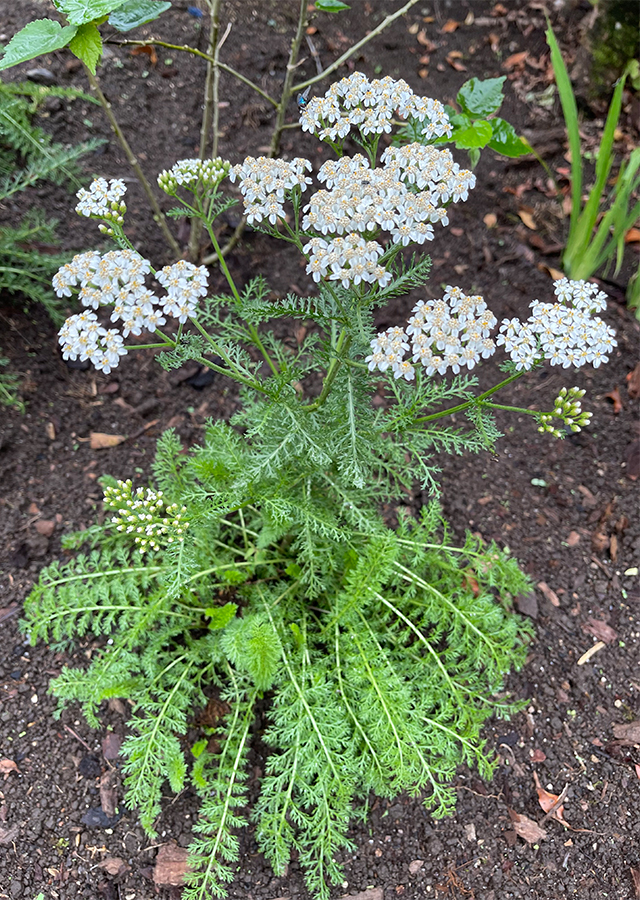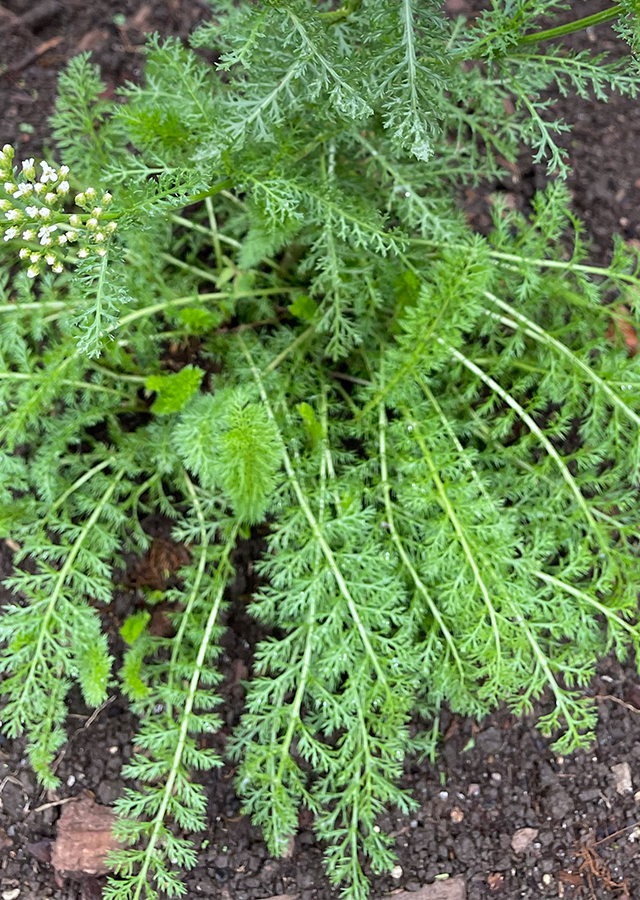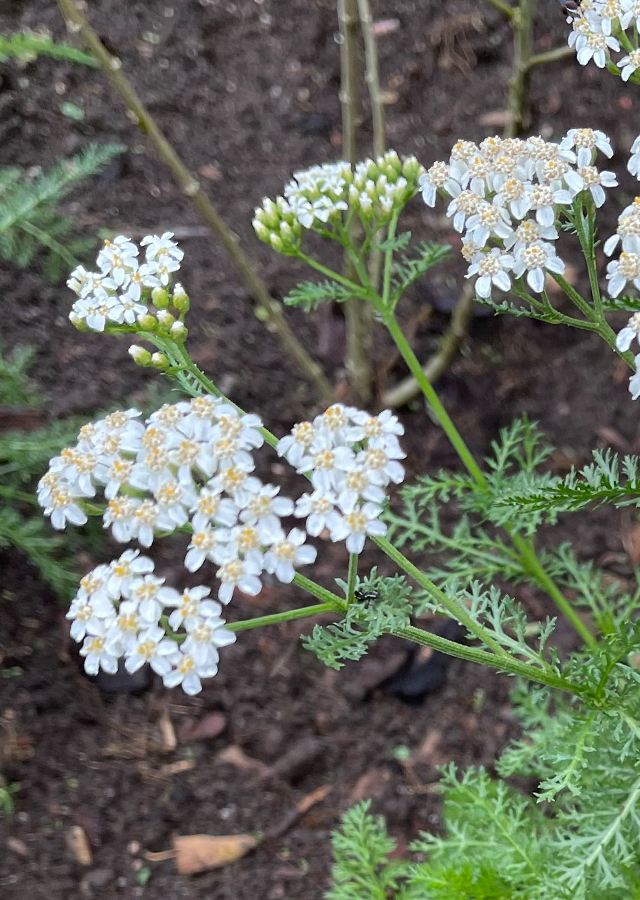Yarrow
Achillea millefolium L.
Asteraceae
Location in our garden
Principal



Synonym
Achillea dentifera DC.
Achillea tenuifolia Salisb.
Alitubus millefolium (L.) Dulac
Habitus
Herbaceous. An erect perennial herb growing to a height of 50 to 90 cm
Part Used
Leaves
Flowers
The Whole Plant
Growing Requirements
Full Sunshine
Need Shade
Drought Resistant
Low Temperature
Habitat
Riverbanks
Forest
Coastal
Roadside
Rocky Areas
Shrublands
Grassland
Terrestrial
Overview
A. millefolium has a wide distribution, considered as native to Eurasia and North America and found primarily throughout the temperate and boreal zones of the Northern Hemisphere and, to a lesser extent, in the Southern Hemisphere. Yarrow is one of the oldest plants known to have been used by humans and cultivated for medicinal properties and as an ornamental plant.
Vernacular Names
Om alf waraka (Arabic), Ou shi (Chinese), Millefeuille (French), Tausendblatt (German), Millefoglie (Italian), Seiyou no kogirisou (Japanese), Alcanfor (Spanish).
Agroecology
Grows in areas at altitudes from sea level to mountainous areas (0 - 3,600 m asl) and is found growing in a variety of habitats including grasslands, forests, riverbanks, fallow fields, grassy waste areas, edges of trails, yards, fences. It is also one of the understorey species in boreal forests. This species can grow well in almost all types of soil, temperature, climate and altitude. Found in dry or sandy soils, moist, loamy, and salty soils, with low levels of nutrients and moisture. Generally grows in open areas but tolerant of shade. This species is also drought and frost tolerant (tolerates temperatures up to approx. -25 °C), but not flood tolerant.
Morphology
- Stems - erect, simple or branched, densely lanate-tomentose to glabrate.
- Leaves - petiolate (proximally) or sessile (distally, weakly clasping and gradually reduced); blades oblong or lanceolate, 3.5–35+ cm × 5–35 mm, 1–2-pinnately lobed (ultimate lobes ± lanceolate, often arrayed in multiple planes), faces glabrate to sparsely tomentose or densely lanate.
- Flowers - pistillate, fertile; corollas white or light pink to deep purple, laminae 1.5–3 × 1.5–3 mm. Disc florets 10–20; corollas white to grayish white, 2–4.5 mm.
- Fruits - compressed achene, small, oval or ovoid, without pappus, brown.
- Seeds - round, flat and black.
Cultivation
Propagated by seeds or stem cuttings - seeds usually germinate in 1 - 3 months.
Chemical Constituents
Alkaloids (achilleine, achilletine, and moscatine), flavonoids (apigenin and luteolin-7-O-glucoside), glycosylflavones (mainly swerticin, vicenin-2 and -3, schaftoside and isoschaftoside), 6-methoxylated or di- and tri- flavonols methylated (such as pectolinarigin, 3- methylbenzoetol and 3,6,4'-methylquerccetagetin), polyyne, alkylamides, triterpenes, saponins, coumarins, tannins, essential oils (azulene, eucalyptol, camphor, alpha-terpineol, beta-pinene, α-pinene, 1,8-cineole, sabinene, myrcene, linalool, β-thujone, α-thujone, α-phellandrene, limonene, and borneol), aconitic acid, nuline, asparagine.
Traditional Medicinal Uses
- Considered anti-inflammatory, antioxidant and antimicrobial.
- Used for colds, fevers, obstructed perspiration.
- Use to open the pores in obstructed perspiration and as blood purifier.
- Used for hysteria, flatulence, heartburn, colic and epilepsy.
- In England, used as vulnerary, taken internally to suppress hemorrhages and profuse mucoid discharges.
- Used for intermittent fevers and as antispasmodic in flatulent colic and nervous affections.
- In France, hot infusion used as emmenagogue and for suppression of lochia; sometimes used in low exanthematous fevers with obstinate eruptions.
- Ointment of the fresh plant used by the Scottish Highlanders for hemorrhoids.
- Decoction of whole herb used for bleeding hemorrhoids and kidney disorders.
- Used as hair wash for prevention of baldness.
- Fresh bruised herb used as vulnerary and styptic.
- In Norway, used for rheumatism; leaves chewed for toothaches.
- In Scotland, fresh leaves used for colds and various childhood ailments.
- In France, powdered leaves used as sternutatory; rolled leaf applied to nostrils to induce bleeding and relieve headaches.
- In California, leaves steeped in hot water are applied to cuts and bruises; also used for poulticing skin rashes.
- Leaves chewed for toothaches; infusion used as drops to fill ear canals for earaches.
Part Used
Reference Sources
- Royal Botanic Gardens. Plants of the World Online: Achillea millefolium L. https://powo.science.kew.org/taxon/urn:lsid:ipni.org:names:2294-2. 04-04-22.
- Stuartxchange. 2019. Philippine Alternative Medicine: Milfoil. http://www.stuartxchange.org/Milfoil.html. 04-04-22.
- PROSEA. 2018. Achillea millefolium (PROSEA). https://uses.plantnet-project.org/en/Achillea_millefolium_(PROSEA). 04-04-22.
- CAB International. 2022. Invasive Species Compendium: Achillea millefolium (yarrow). https://www.cabi.org/isc/datasheet/2636#toidentity. 04-04-22.
- Useful Temperate Plants Database. 2021. Achillea millefolium. http://temperate.theferns.info/plant/Achillea+millefolium. 04-04-22.


